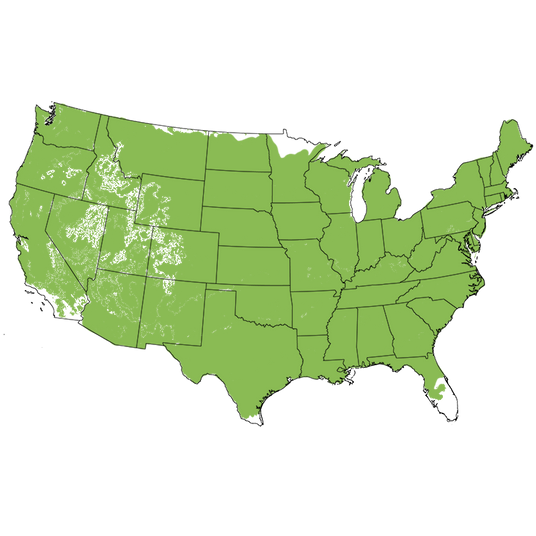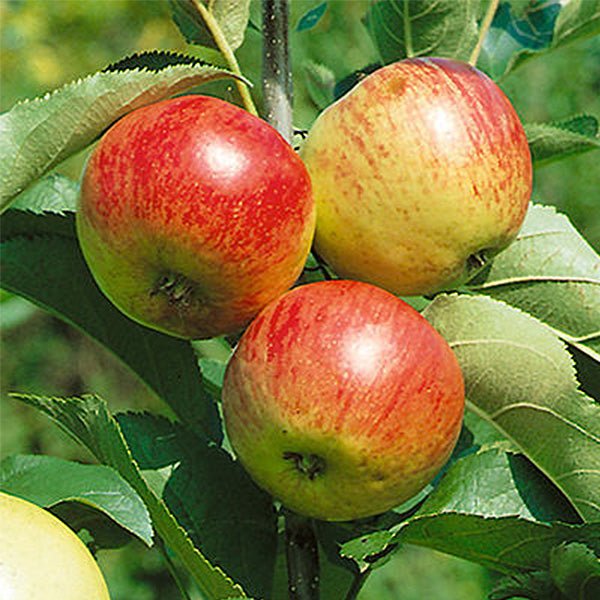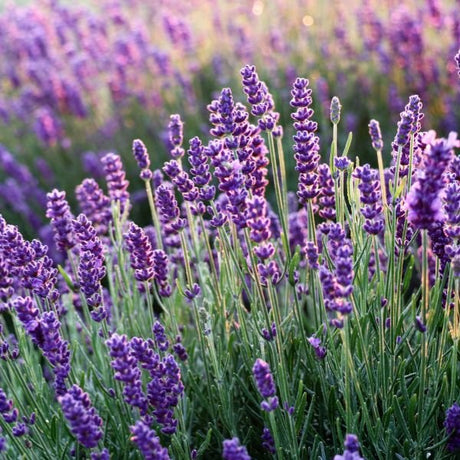Liberty Apple Tree
Malus x 'Liberty'
- Stay Protected with Plant Sentry ™
Liberty Apple Tree is backordered and will ship as soon as it is back in stock.
Plant Sentry™
Plant Sentry™

Plant Sentry™ Protected
Your order is protected by our compliance system that:
- Prevents restricted plants from shipping to your state
- Ensures plants meet your state's agricultural requirements
- Protects gardens from invasive pests and diseases
Delivery and Shipping
Delivery and Shipping
Delivery and Shipping
Fast, Safe Plant Delivery
Ships in 3-4 business days • Tracking provided • Weather protected
| Under $50 | $9.99 |
| $50 - $99.99 | $14.99 |
| $100 - $149.99 | $16.99 |
| $150+ | $24.99 |
✓ Zone-specific timing • ✓ Professional packaging • ✓ Health guarantee
Understanding Plant Options
Nature Hills offers plants in two main formats:
- Container Plants: Grown in pots with soil, sized by container volume and plant age
- Bare Root Plants: Dormant plants without soil, sized by height measurements
Container Plant Sizes
Container sizes indicate plant age and growing capacity rather than liquid volume equivalents. Our containers follow industry-standard nursery "trade gallon" specifications, which differ from standard liquid gallon measurements.
Young Plants (6 months to 18 months old)
| Container Size | Actual Volume | Metric Equivalent |
|---|---|---|
| 2" x 2" x 3" | 0.18 - 0.21 dry quarts | 0.20 - 0.23 dry liters |
| 4" Container | 0.31 - 0.87 dry quarts | 0.35 - 0.96 dry liters |
| 4.5" Container | 0.65 dry quarts | 0.72 dry liters |
| 6" Container | 1.4 dry quarts | 1.59 dry liters |
| 1 Quart | 1 dry quart | 1.1 dry liters |
| 5.5" Container | 1.89 dry quarts | 2.08 dry liters |
Established Plants (18 months to 2.5 years old)
| Container Size | Actual Volume | Metric Equivalent |
|---|---|---|
| 2 Quart | 2 dry quarts | 2.2 dry liters |
| #1 Container | 2.26 - 3.73 dry quarts | 2.49 - 4.11 dry liters |
| 5" x 5" x 12" | 3.5 - 4.3 dry quarts | 3.85 - 4.74 dry liters |
Mature Plants (2-4 years old)
| Container Size | Actual Volume | Metric Equivalent |
|---|---|---|
| #2 Container | 1.19 - 1.76 dry gallons | 5.24 - 7.75 dry liters |
| #3 Container | 2.15 - 2.76 dry gallons | 8.14 - 12.16 dry liters |
Large Plants (3-5 years old)
| Container Size | Actual Volume | Metric Equivalent |
|---|---|---|
| #5 Container | 2.92 - 4.62 dry gallons | 12.86 - 20.35 dry liters |
| #6 Container | 5.25 - 6.01 dry gallons | 23.12 - 26.42 dry liters |
| #7 Container | 5.98 - 6.53 dry gallons | 26.34 - 28.76 dry liters |
Bare Root Plants
Bare root plants are sold by height from the root system to the top of the plant. Plants may exceed minimum height requirements.
Common Sizes:
- Trees: 1 foot, 2 feet, 3 feet, 4 feet, 5 feet, 6 feet
- Shrubs & Perennials: 1 foot, 18 inches, 2 feet
Important Notes
Container Volume Specifications
- Trade Gallon Standard: Our containers follow industry-standard "trade gallon" specifications established by the American National Standards Institute (ANSI Z60.1) for nursery stock
- Volume Variations: Actual soil volume may vary due to plant root systems and growing medium settlement
- Age Indicators: Container size primarily indicates plant age and maturity rather than liquid volume equivalents
Growing Conditions
- Plant size can vary based on variety and growing conditions
- Container size helps indicate plant maturity and establishment level
- Larger containers generally mean more established root systems and faster landscape establishment
Seasonal Availability
- Bare root plants are available seasonally when dormant
- Container plants are available throughout the growing season
- Specific varieties may have limited availability in certain sizes
Questions?
For questions about specific plant sizes or availability, please contact our plant experts who can help you choose the right size for your landscape needs.
Plant Highlights
Liberty Apple Tree highlights at a glance!
-
Botanical Name
-
Brand
-
Growing Zones4, 5, 6, 7, 8, 9
-
Growth RateModerate
-
Mature Height
-
Mature Width
-
Leaf Color
-
Flower Color
-
Pollinator FriendlyYes
-
Pollinator Required
-
Bloom PeriodEarly Spring
-
FragrantYes
Characteristics
Where To Plant
When To Prune
- Late Winter
Water & Moisture Needs
- Moderate
Sunlight Needs
Soil Needs
- Well Drained

Growing Zones
Healthy, Heavy Bearer Liberty Apple Tree
- Very Disease Resistant Tree
- Vigorous
- Becomes the Mainstay of Your Apple Orchard
- Late Season
- Crisp Texture
- Bright, Sweet and Tart Flavor
- People Rave About the Taste
- Fresh Eating, Canning, Baking and Keeping Baking Apple
- Good Keeping Apple
- Widely Adaptable
- Recommended Pollinators: McIntosh, Yellow Transparent, Cortland, Zestar
- Shows Resistance to Apple Scab, Fire Blight, Cedar Apple Rust and Powdery Mildew
If you ever lose an Apple tree, replace it with a Liberty Apple (Malus 'Liberty'). This late-season favorite is a reliable producer. It's also wonderfully disease resistant, and a great choice for low-spray backyard orchards.
With juicy and crisp yellow flesh is sweet enough for great fresh eating. But, the flavor has enough complexity with just enough tart to hold its own in baking and ciders.
These trees provide a reliable harvest of medium-sized fruit with an excellent texture. Beautifully dark red blush covers most of the golden yellow background, and you'll enjoy the citrusy flavor added by tiny yellow lenticel "speckles".
Hybridized by Cornell University, this cold-hardy tree ripens late. Keep these apples for months with proper storage, and they'll sweeten up for you.
Liberty has earned its badge of honor as one of the best trees for resistance to fire blight, Cedar Apple rust and Apple scab in many areas.
These valuable fruiting trees are in high demand. If you see Liberty Apple in stock on the site, place your order right away, or you'll risk having to wait until next year.
How to Use Liberty Apple Tree in the Landscape
Liberty is a best-selling New York state apple but works for landscape across the country. This vigorous, healthy, hardy and productive hybrid makes a special impact in your yard.
Join the Edible Landscape movement and make your sunshine work for your family. It's great to know exactly how your fruit was grown, as well.
Plant a mini orchard near a child's play structure. Watch the baby fruit develop from white flowers in spring through the finished harvest.
The display is very ornamental. People are starting to get excited about fruiting plants, and Liberty is a great choice.
Use the sweet-tart fruit for a snack, or prep them with other late-season apples for a cobbler. Keep them, or sauce them. Create outstanding dried Liberty fruit leather, and you can decide how much sugar it needs. (Not much!)
Use Liberty as a focal point with a pollination partner. If you have the space, let them grow to their full size and spread in a mulched garden bed.
Or, keep the trees as small as you like with annual pruning for size control each summer. It's easy to keep them pruned down to as small as 6 feet tall and wide. You'll have an easier harvest!
Ensure pollination by planting several Apple trees together. Add an early and mid-season variety with Liberty in a high density planting. You'll be delighted with their good looks, and a successive harvest of great-tasting fruit.
#ProPlantTips for Care
At least six hours of direct sunlight is required for fruiting, but Apple trees will happily take full sunshine all day long. Place them where they will receive morning light for best results.
Site your Liberty trees in an area that gets good air circulation. Soils must drain quickly after a rain event.
Improve drainage by adding dirt in a mounded heap 18 inches high and 3 feet wide. Plant directly in that mound, or add a landscape border for a raised bed.
Water carefully to establish new plants during their first season. Apply supplemental water during summer, when the fruit is developing.
Prune to correct shape and reinforce the branching structure in late winter while your tree is dormant. Remove crossing branches to open up the canopy before new growth appears.
Liberty Apple trees are a perfect mainstay variety for your homestead or Victory Garden. Order soon, don't delay.
Liberty Apple Tree Frequently Asked Questions
When to Plant Liberty Apple Trees
Planting Bareroot trees as soon as you can dig a hole in spring and until hot weather, the earlier the better. Plant container Apple trees throughout the growing season with complete success - that is the benefit of container plants - to extend the planting season. Your County Agricultural Extension Office is a great resource for first and last frost dates in your area.
How to Plant Liberty Apple Trees
Dig a large hole only as deep as needed to accommodate the bareroot or container root ball, and twice as wide. Add Nature Hills Root Booster to speed root establishment. Remove the pot or bag and situate it into the hole so the top of the soil (soil line if bareroot), is level with the new location's soil being careful not to plant too deep. Water in again very well and backfill with the same soil you dug up, tamping down gently to ensure there are no air pockets.
Top off with a 3-4 inch thick layer of Arborist mulch. Consider staking your tree to keep its trunk growing straight for the first year to ensure it stands tall against strong winds and drifting snow.
When to Prune Liberty Apple Trees
Trim off any broken branches from delivery as soon as you take them out of the box. Prune and trim apple trees while dormant, in late winter or early spring, before you see new growth.
How to Prune Liberty Apple Trees
Dormant prune to:
- Remove any double leaders or narrow crotch angles
- Eliminate any crossing branches
- Thin interior branching and leave the fruiting spurs and strong branches in place opening up the canopy
- Branching at least 24-36 inches above the ground
Prune Apple trees in the summer to:
- Control size and shape by reducing the length of longer new growth on vigorous trees
- Remove water sprouts on the main trunk or older branches in the crown
- Remove suckers at the base of the trunk
- Thin fruit during heavy years on established trees
How to Care for Liberty Apple Trees
Growing an apple tree is easy when proper soil, good drainage, attention to moisture, and regular fertility are maintained. Once you've chosen an apple tree that works for your climate, in the size you need for your landscape, and its pollinator (if needed), then you've accomplished half the battle!
- Apple trees do best in full sun and well-drained soil
- Water your apple trees when it gets dry - especially during the fruit production stage, and drought periods to keep it stress-free
- Use arborists' wood chips to mulch over the roots of your apples and have your soil tested to see what your soil may be lacking before adding fertilizers
- Maintenance pruning and shaping
Apple trees will tolerate a wide range of soils, so long as water and nutrients are not limited and the pH level is adequate.
How to Fertilize Liberty Apple Trees
For the first year, water alone is most important. It is always best to get a soil test to see what your soil is lacking before adding more fertilizers. Once established, a fertilizer routine may be beneficial. We do offer some excellent slow-release organic options, applied according to the package directions.
Fruit trees need more phosphate and it's possible to apply too much nitrogen which affects the soil's pH. Test soil acidity or alkalinity using a pH Tester.
Fertilize in spring when you first see new growth emerging.
- Don't overdo it
- Phosphates are your friends
- Pay attention to pH in areas with extremely high or low soil pH
- Follow the directions
Liberty Apple Tree Pollinating Info
Liberty is not self-fruiting and needs a pollinating partner. Pair with one of these varieties:
Harvest Times for Liberty Apple Trees
Liberty’s are typically ready to harvest in September.
Early-Season? Mid-Season? Late-Season? The terminology can be confusing for new apple tree growers. Weather, climate and your tree determine when it's ripe.
For Apples:
- Early-season is usually June-July
- Mid-season can be August-September
- Late-season can be from late September-November
The growing season consists of spring, summer, and fall, and varies with climate and weather. Areas with longer growing seasons in the warmer hardiness zones can greatly affect the harvest times for each particular apple variety grown in your area. Learn which growing zone you are in.
Rootstocks Explained
Apple trees have been grafted onto different rootstocks since before the mid-1800s. Different rootstocks are used to improve the anchoring of trees, eliminate diseases, and reduce the natural mature size of the tree itself. While there are many different types of rootstock, they are all labeled as being either Dwarf, Semi-Dwarf, or Standard.
The apple descriptions, including flowering, pollination, and apple characteristics are the same whether the plant is grown on a standard rootstock or some varying dwarfing rootstock. The overall size can vary by climate and soil but the understock used is ultimately what affects the mature size.
There will be some variation in sizes but as a guide, we are suggesting the overall mature size of these apple varieties are:
Semi-Dwarf Apples
- Height: 12-18 feet
- Spread: 10 - 15 feet
Standard Apples
- Height 18 - 25 feet
- Spread: 15 - 18 feet
Remember that all fruit tree sizes can easily be altered if needed by simple pruning as the trees grow and develop.








